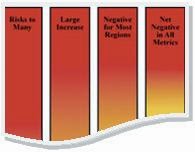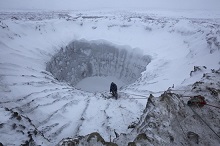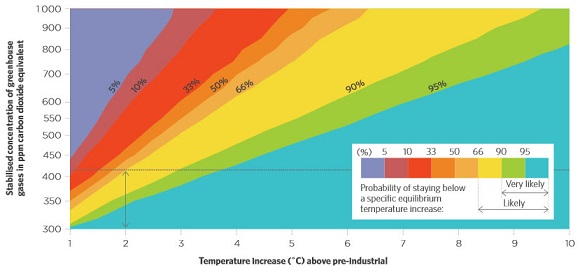Back in 2001 the IPCC devised the famous Burning embers graph to reflect a broad perspective of risks emanating from climate change. Seventeen scientists have now had another look, original paper here. The graph has been enhanced with more information, which is itself more up to date. Continue reading Climate risks re-examined
Tag Archives: Climate risk
Quiggin on climate risk
John Quiggin has a post Climate change and catastrophe wherein he links to his article in The Economist Why the Paris conference may not be enough. I know from the WordPress software that people are slack in following links, so I’ll try to give a sense of what he said. Continue reading Quiggin on climate risk
Climate clippings 154
1. Hunt stacks Climate Change Authority with Coalition advisors and ex MPs
The Climate Change Authority has been a thorn in the side for the Abbott Government, as we’ve seen over time. The Abbott government tried to kill the Authority, but was thwarted by the Senate.
Now Bernie Fraser, John Quiggin, David Karoly and other good people have been replaced by a bunch who support Direct Action as a policy and seem less than enthusiastic about renewable energy. If the comment by Larissa Waters at the end of the linked piece is correct the Nationals did a “deal with Malcolm Turnbull to keep Tony Abbott’s woeful climate policies in exchange for support.” Continue reading Climate clippings 154
Dealing with the methane time bomb
Is the melting Arctic poised to release catastrophic quantities of methane? Actually, that’s one thing we don’t have to worry about, says Anil Ananthaswamy in a New Scientist article (paywalled). I’ve read the article, and I haven’t quite stopped worrying. Not quite. Continue reading Dealing with the methane time bomb
Climate clippings 130
1. Manicured lawns produce more greenhouse gases than they soak up

Researchers found:
that a hectare of lawn in Nashville, Tennessee, produced greenhouse gases equivalent to 697 to 2,443kg of carbon dioxide a year. The higher figure is equivalent to a flight more than halfway around the world.
Climate clippings 119
1. Abbott appoints fruitcake to assist Greg Hunt
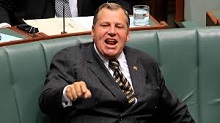
He says he’s not a denier or a sceptic, so let’s just call him a fruitcake. In the recent ministerial reshuffle Bob Baldwin has been moved from Parliamentary Secretary to the Minister for Industry to Parliamentary Secretary to the Environment Minister.
Baldwin told the Chinese that the climate had been changing for millions of years and we wouldn’t have coal, oil or gas without climate change. That’s a typical denialist tack. Elsewhere he quoted that well-known authority on everything, Queensland radio shock-jock Michael Smith. If the atmosphere was a bridge a kilometre long, he said, the first 770 metres would be nitrogen, the next 210 metres oxygen, and so on until you come to CO2. Australia’s contribution of CO2 is the equivalent to 0.18 millimetres, the width of a human hair.
2. Bernie Fraser sends a Christmas message to Abbott

Basically, keep the Renewable Energy Target (RET), it all you’ve got, and the Emissions Reduction Fund (ERF) may not meet its initial target of 5% emissions reductions by 2020. In any case it is not scalable to meet the targets we are likely to be committed to post 2020.
The Climate Change Authority has just completed its review of the RET and a review of the Carbon Farming Initiative (CFI), as mandated in the establishing legislation. I’d recommend reading Bernie’s Chairman’s Statement.
The CCA recommends extending the achievement date of the RET by up to three years, but this is the big picture:
The Authority has argued consistently throughout its short life that an effective policy response to the risks of climate change requires favourable winds on at least two fronts:
• first, a broad community consensus that climate change poses real risks to the community; and
• secondly, a well-stocked toolbox to be able to tap into opportunities to reduce emissions wherever they occur.
Neither exists today. The earlier broad political consensus has ruptured in recent years, and no early repair is in prospect. And the tool box is feeling less weighty, with the removal of the carbon pricing mechanism, an unproven ERF, and an uncertain outlook for the RET.
There’s more from Giles Parkinson who calls it “a damming assessment of Abbott government climate policy” and from Sophie Vorrath.
3. Harper flags carbon price rethink for Canada
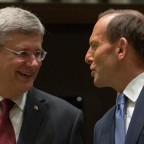
Before Christmas when Tony Abbott was asked what he’d achieved as Minister for Women he nominated dumping the carbon tax. At the same time the Canadian PM Stephen Harper, Abbott’s soul-mate on climate policy, suggested that he was open to a country-wide carbon pricing scheme similar to the one implemented in Alberta.
In Alberta, energy heavy polluting companies are required to reduce their energy intensity, or improve their energy efficiency, annually. If they don’t, they must contribute to a technology fund at $15 a tonne for carbon emissions.
“I think it’s a model on which you could, on which you could go broader,” Harper said in Wednesday’s interview.
Tesla is opening a battery swap station between Los Angeles and San Francisco on a pilot basis to see whether the idea goes anywhere. Zachary Shahan, the author of the linked piece, suggests perhaps not. The swap must be done by appointment and although it may be completed in less than a minute it would cost almost as much as a tank of premium. The alternative is free Supercharging for Tesla owners.
5. Technology on the move
In the same issue of RenewEconomy as the Tesla battery swap item above were three other technology announcements.
First, the ASX listed company Algae.Tec has issued rights to raise capital to build an algae biofuel plant in India.
Second, the ADF is looking to replace diesel generation with renewable energy to power Bathurst Island, north of Darwin, probably wind and solar.
Third, a solar plant that floats on water is being launched in South Korea.
6. Banks begin to take climate risk seriously
The large investor Australian Super has been asking banks about their climate change risk policies. It sounds as though banks are pretending to be more active than they really are, but it is clear that the investment landscape has changed forever. If the banks have not been actively concerned, they soon will.
Former Coalition opposition leader John Hewson, who chairs the Asset Owners Disclosure Project
is considering “naming and shaming” how the world’s 1000 biggest banks are responding to carbon risk, something it already does for pension funds.
The game is up
In the post A choice of catastrophes: the IPCC budget approach I explained the socalled ‘carbon budget approach’ in some detail. In general terms:
- In a warming world what matters is the total quantum of CO2 in the atmosphere. The ‘climate budget approach’ identifies the total anthropogenic CO2 emitted to cause warming of 2°C. For a 66% chance of staying under 2°C the total CO2 emitted must not exceed 1000Gt, according to calculations done by Malte Meinshausen and others back in 2009. The later we leave cutting the harder we have to cut.
Rahmstorf’s budget was about 1000Gt of CO2 or about 1500GT of CO2 equivalent with other greenhouse gases for a 25% chance of staying within 2°C. Then
- as Giles Parkinson reports, the carbon budget figures have taken a haircut to become 800Gt for a 66% chance of 2°C when “accounting for non-CO2 forcings”. Problem is we’d already used up 543Gt of the budget by 2011.
David Spratt now tells it straight: Continue reading The game is up
Climate Change Authority review
In late February the Climate Change Authority published a Draft Report of its Targets and Progress Review.
The full draft report (all 265 pages) is downloadable from the first link above. Unfortunately I don’t have time to read all of it. Clive Hamilton at The Conversation has written an excellent overview. Continue reading Climate Change Authority review
Climate clippings 83
 These posts are intended to share information and ideas about climate change and hence act as an open thread. Again I do not want to spend time in comments rehashing whether human activity causes climate change.
These posts are intended to share information and ideas about climate change and hence act as an open thread. Again I do not want to spend time in comments rehashing whether human activity causes climate change.
This edition contains items, exclusively, I think, in climate science and impacts. The thread is meant to function also as a roundtable to share information and ideas.
1. Climate change picked the crops we eat today
The New Scientist carries a story about how some cereals we know today were changed by the climate as we came out of the last ice age. Researchers at the University of Sheffield, UK took seeds of precursors of modern wheat and barley found with human remains in a 23,000-year-old archaeological site in Israel. They grew these together with four wild grass species that aren’t eaten today, but were also known to grow in the region at that time, and grew them under conditions replicating levels of CO2 then and also the higher levels when farming first arose 10,000 years ago.
All the plants grew larger under the higher levels of CO2, but the relatives of wheat and barley grew twice as large and produced double the seeds. This suggests the species are especially sensitive to high levels of CO2, making them the best choice for cultivation after the last ice age.
The team plan to look at whether other food staples around the world are similarly affected by elevated CO2 levels, for example millet grown in Asia and maize in North America. They also plan to compare the effects of CO2 on legumes such as peas. Continue reading Climate clippings 83
Climate clippings 50
This is serious!

First we were told that rising temperatures would make it difficult to grow tea in
Uganda and in Kenya, then it was going to become too hot for chocolate. Now Starbucks is warning that climate change will threaten the world supply of coffee.
This story has gone viral, but I liked this neat post. Obama should indeed do something. What Al Gore said. Continue reading Climate clippings 50
Climate clippings 33

2010 possibly the worst ever for extreme weather
That’s according to über-meteorologist Jeff Masters posting at Climate Progress.
The year was extraordinary, featuring the hottest year on record equalling 2005, the most extreme winter Arctic atmospheric circulation on record, the warmest and driest winter on record for North America-Canada, the lowest volume of Arctic sea ice on record and 3rd lowest in extent, a record melting in Greenland, the second most extreme shift from El Niño to La Niña, the second worst coral bleaching year, the wettest year over land, the Amazon rainforest experienced its 2nd 100-year drought in 5 years and, it must be said, we had the lowest global tropical cyclone activity on record. Here’s the precipitation graph: Continue reading Climate clippings 33
Climate clippings 32

The little ice age cometh – not!
You may have seen the headlines:
“Three different lines of evidence suggest that the sun, which is expected to reach its maximum sunspot and magnetic activity in the current cycle in 2013, might even be entering a prolonged quiet period similar to the so-called Maunder Minimum, a 70-year period from 1645 to 1715 in which virtually no sunspots were observed.”
While the SMH was quite responsible, Fox News maxed it up:
Global Warming Be Damned, We Might Be Headed for a Mini Ice Age
The New Scientist tells us that last year:
researchers modelled what would happen to global temperatures if a grand minimum started now and continued until 2100. They found that it would lower temperatures by 0.3 °C at most.
That isn’t a new ice age: it’s a slightly less severe heatwave.
Skeptical Science has more, including this graph:


